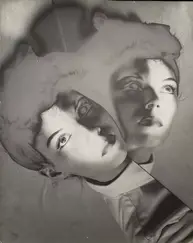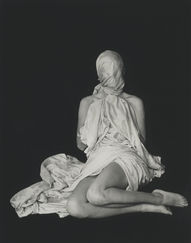

Erwin Blumenfeld was a fashion photographer who used colour and black and white. Erwin also experimented with inverting his images at specific segments within the photos which made them look more ghostly. The inverted parts were also used as shadow on the face. He used lighting, contrast and textured glass to add a level of abstract to the subject.
Style

analysis
This photograph is of a man with a distorted face which almost looks like crumpled up paper. This photo is a close up with the main focal point of his 'face'. It was taken in black and white using hight contrast and harsh lighting to emphasise the creases within the crumpled face. this photo is a self-portrait.
Erwin took this image in 1958 and named it 'self-portrait'. He was working with vogue at this point in time however this image was not in one of the magazines as it is not fashion photography like the majority of his imagery. this photo is quite unnerving, playing with the way that humans feel uncomforted by distorted human faces (uncanny valley).
Blumenfeld would have probably used an ISO bellow 400 with aperture as the priority. the aperture would have been set to around F/5.6 as the background is slightly blurred but not majorly, meaning the focal length is pretty average.

this image is relating to others of his photos due to the discomforting nature of composition and creative use of black and white. I personally interpret this image as an exaggerated depiction of facial dysmorphia. Facial dysmorphia is a disorder that when you look. in a mirror, your face is distorted. From this image, i have learnt about high contrast in black and white photography to emphasise details. i have also learnt about the use of props in photography to send feeling to the viewer of what you wish to convey.

This image is very unclear and undetailed. the image is shot in B&W and shot against the light to make the figure look like a silhouette yet still very softly illuminating her nose. Erwin has used double exposure here to create the pattern of the background showing through the figure to make them look almost like a specter. this image is composed with the figure central and is a portrait in orientation.
This image was taken in 1940 while he was doing photography for vouge. Erwin specialized in fashion photography. this image is quite ominous in nature due to the common fear of the unknown as you can not really see the subject only their ghostly figure.
He would have used a narrow aperture (probably around f/11). The ISO would have been as low as possible and the shutter speed would have a relatively average shutter speed to create the silhouette look.
Analysis
This photo relates to his other photos through its quirky nature and its black and white photography. Quite a lot of Blumenfeld's photography is also relatively unnerving to the viewer. an interpretation of this image which I have created for myself is about feminism. My idea is about how woman are often seen as 'invisible' and how they are often overlooked in our society. This will influence my work for my more spooky photos and films. I can use these techniques to provoke fear in my viewers with ghostly apparitions and unknown figures. I have learnt camera skills (such as double exposure, use of ISO and the use of aperture) to created ghostly imagery as well as black and white to imitate photos due to ghosts being from the past.
















